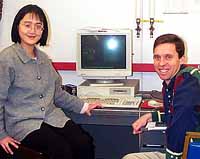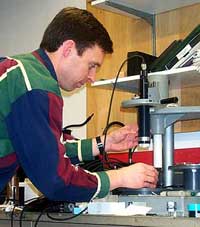Jim Valles

Valles and Zhenyi Long, a graduate student, discuss her scanning tunneling microscope images.

Valles adjusts microscope for a better view of eggs.
A physicist at Brown University, Valles uses strong magnetic fields to cancel the effects of gravity on frog embryos, so they float in thin air. He then works with two biologists to analyze the effects of zero gravity and strong magnetic fields on frog development. “I consider [seeing] the levitation to be a magical thing, ” Valles said. He also enjoys working the levitation project, which includes elements from both physics and biology. “Doing work at a boundary in science is really fun, and is a great way to develop perspective on where your own work as a scientist fits in, ” Valles said.
Valles's project was born from a 1994 hallway conversation with a colleague, Humphrey Maris. Maris used powerful magnets to levitate drops of liquid helium, and he casually mentioned that water was even more magnetic than helium. Valles realized that living things are mostly water, so if a powerful magnet could levitate water, it could levitate living things too. Valles called two biologists from Brown, Kimberly Mowry and Jim Denegre, who studied frog embryos; Valles told them about the idea. “It was easy to see that levitation would work for frogs. The simple physical argument that Maris had given me had convinced me completely, ” Valles said. They wrote a funding proposal to NASA. “I realized they were not going to believe it until they saw it, ” he said. Valles and his collaborators levitated an embryo, took a picture of it floating in the air, and submitted the picture with their proposal. After a couple of tries, they received the grant, and they continue to study magnetic levitation today. “I would like to know how a fundamental thing, these magnetic fields, interact with the other big fundamental thing around us, which is life, ” Valles said.
Valles was born in White Plains, New York. He enjoyed high school - “my peers were really bright people that were exciting to be around, ” he said. He went on to Dartmouth College and graduate school in physics at the University of Massachusetts-Amherst. After two years at the University of Oregon, Valles took his current job at Brown. He has taught physics classes since graduate school, and his teaching style has been popular with his students. “I like understanding something in a clear enough way that I can explain it to others… and if it's something that is brand new, it's even better. ” Valles said. “It really has to do with physics things, ” he added. “Don't ask me why it's physics. [Other fields] just don't hold the same charm for me. ”
Valles has three children, two boys and a girl. He runs in road races and coaches children's soccer. “It's fun to try to teach your body to do new things, like how to play soccer a little bit, ” he said. “It's very humbling to try to learn how to dribble a soccer ball, and then watch a nine year old learn it much faster than you do. ”
Frogs have worked as subjects in physics experiments before. In fact, one of the most important discoveries in the history of physics was made by a frog.
In 1791, the study of electricity was one of the hottest areas of physics. Physicists collected electric charge through static electricity, but the charge always dissipated quickly. Physicists had only a few seconds to carry out their experiments before the thing they were studying disappeared.
That year, Luigi Galvani, a professor of anatomy at the University of Bologna, was dissecting a frog. He touched his metal scalpel to a nerve in the frog's leg, and the leg kicked. Galvani guessed that his scalpel had sent an electric pulse through the frog's nerve. To test this idea, he hung frogs' legs from brass hooks on an iron gate in his garden.
The legs kicked only once, when Galvani first touched the brass hooks to the iron gate. He told his friend Alessandro Volta, a professor of physics at the University of Pavia. Volta guessed that the frogs' legs did not produce the electricity; they merely served as a detector for an electric pulse caused by the contact between two different metals, brass and iron.
Volta repeated Galvani's experiment with many different metals, and found the greatest pulse came from a pairing of silver and zinc. He made a pile from several layers of silver and zinc plates, with wet cardboard between. The resulting invention, the 'Voltaic pile,' produced a continuous flow of electricity - it was the world's first battery. For the first time, physicists had a constant source of electricity for their experiments. Today, the basic unit of electric potential, the Volt, is named for Alessandro Volta. The device that measures current, the galvonometer, is named for Luigi Galvani.











